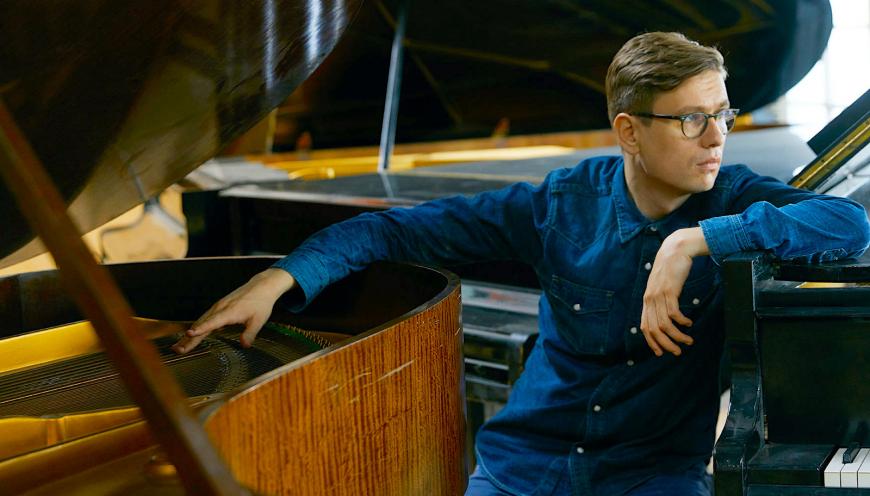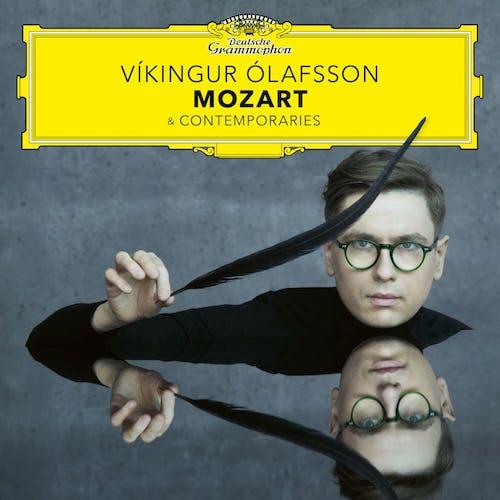
It is fair to say that pianist Víkingur Ólafsson may be the most celebrated musician to come out of Iceland this side of Björk, with a writer from The New York Times going so far as to say that he is “Iceland’s Glenn Gould.” That’s dangerous hype, for Ólafsson doesn’t need comparisons with other icons. His recordings have shown that he has his own unique conceptions of sound and programming, and his latest release, Mozart & Contemporaries (Deutsche Grammophon), continues the pattern.

First, the sound. Ólafsson has a disarmingly exquisite touch and projects it in a way that gives his playing a cool, slightly distant feeling. That all of his CDs for DG have been recorded in the same gently reverberant hall in Reykjavik adds to the unified profile, reflecting the ambience of a remote spot on the globe that I hear in almost all music coming from Iceland, be it classical, rock, or folk.
Then there is the programming. As he does in his pleasing debut album of Philip Glass etudes and an astonishing album of J.S. Bach pieces (which in turn spawned a moody set of electro-acoustic “remixes,” Bach Reworks), Ólafsson strings together another collection containing well over an hour of short pieces. He roams almost in a manner of free association through Mozart with side trips to C.P.E. Bach and Haydn and intros from the Italian contemporaries Domenico Cimarosa and the little-known Baldassare Galuppi, whose surprisingly delectable Andante spiritoso from his Sonata No. 9 leads off the album.
Ólafsson’s goal, as he writes in his always-absorbing booklet notes, is to approach Mozart and company “with the same freedom, childlike enthusiasm, and spirit of discovery.” He’s downright unpredictable about it, too. Thus, while Mozart’s stormy Sonata No. 14 K. 457 is given a straightforward rendition, he takes all kinds of liberties in attacks and appoggiaturas in the familiar, easy Sonata in C, K. 545 that many of us played as kids. Similar things happen in Haydn’s Sonata No. 47, playing sharp staccato notes when legato smoothness is indicated, everything impeccably executed. Here, references to the Gould model do make sense.
His Mozart Fantasia in D Minor K. 397 is a limpid thing that exploits the tragedy subtly hidden in the score for all it is worth, and then when things come to a crawl before it shifts into D major, he cuts it off and embarks upon the jolly Rondo in D K. 485. This kind of freedom might rattle the academics, but it makes for an interesting jolt to the listener — and he’s right; it’s a more satisfying follow-up than the D-major section in an “urtext” score of K. 397 that I consulted. He also takes it upon himself to transcribe the slow movement from the String Quintet K. 516 for solo piano and adds harmonization to the two small Cimarosa sonatas to make them sound on a modern concert grand.
Ólafsson was set to bring the first two-thirds of this program, along with excerpts from his Glass and Debussy/Rameau albums, plus the Mozart Piano Concerto No. 24, to the Ojai Festival over the past weekend (Sep. 18–19). Since I am writing this before the concerts took place, and having heard Ólafsson replicate his unique touch live in Los Angeles away from his hometown hall, I imagine that this mostly-inward-looking collage of Mozart and his colleagues and influencers would be quite effective underneath the ancient Ojai sycamore tree.




